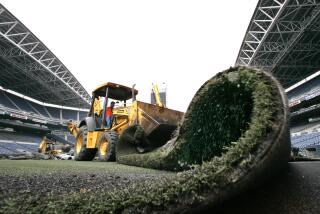Instead of lippia, try these lawn substitutes
Question: When I moved to Northridge in 1951, every nursery carried flats of lippia, a cheap, tough, drought-resistant ground cover and lawn substitute. When I ordered it at a nursery, it took months to get, in spite of the fact that it is grown in Northern California, and it was expensive. Do you know why it has disappeared?
Florence “Flip” Manne
Sun Valley
Answer: Florence, you are right -- getting rid of grass is a great goal. Traditional lawns take so many resources -- water, time, money, chemicals -- while contributing so little to the aesthetic of a property.
Before we get into the mystery of lippia’s disappearance, let’s consider a few inexpensive, drought-resistant, readily available lawn alternatives that may suit your design needs. I’m suggesting three of varying heights, all with the qualities you attributed to lippia:
Yarrow
If you prefer a lawn-like look, try Achillea millefolium, commonly known as yarrow, for a year-round deep green. It’s one of the plants my firm uses for its IdealMow alternatives -- lawns or meadows consisting of California natives and other plants suited to thrive in L.A. County with little maintenance, scant water and no synthetic chemicals. For the look of a traditional lawn, mow yarrow to a height of 3 inches once a month. A wildly attractive alternative: Don’t mow it, and allow yarrow to develop beautiful stalks of white flowers.
Hummingbird sage
For a rustic design, it’s hard to beat the charms of Salvia spathacea, better known as hummingbird sage. Its large, low, soft leaves will spread on their own, growing 12 to 18 inches high with multi-flower stalks appearing sporadically throughout all seasons. It will happily maintain a mild, shady slope and will thrive beneath fussy oaks with little or no water. As you may have guessed, hummingbird sage also attracts wildlife.
Breath of Heaven
The striking gold foliage of a Coleonema pulchellum cultivar called Sunset Gold grows 2½ feet high and can make a visual effect in groupings. For a contemporary look, place alternating masses of contrasting blue-colored foliage such as Festuca idahoensis adjacent to Sunset Gold. For drama, you could place architectural plants such as Agave attenuata to appear as if they are erupting from a sea of gold. This Coleonema is often sold under the name Breath of Heaven or Golden Breath of Heaven.
Each of these alternatives can be found at nurseries, and yarrow can be started economically from seed. They require no fertilizers to stay in optimal condition, and they demand about 70% less water than a traditional lawn. They have one other benefit that distinguishes them from lippia: They are not invasive.
Now we get to the mysterious disappearance of lippia (Phyla canescens). The plant spreads aggressively, so aggressively that it may invade not only the adjacent garden but also our region’s wild spaces. Much of what we’ve come to see as our inevitable cycle of fires and floods can be attributed to the proliferation of invasive species inadvertently introduced to our wild lands through our home gardens.
Although some of the worst offenders, including fountain grass, pride of Madeira, broom and pampas grass, are still sold in nurseries, standards are evolving. Lippia’s disappearance is part of this evolution.
Our expert
Our answer this week comes from Cassy Aoyagi, co-founder and president of FormLA Landscaping, www.formlainc.com. She is an accredited designer in the U.S. Green Building Council’s Leadership in Energy and Environmental Design (LEED) program, a licensed contractor and board president of the Theodore Payne Foundation for Wildflowers and Native Plants.






